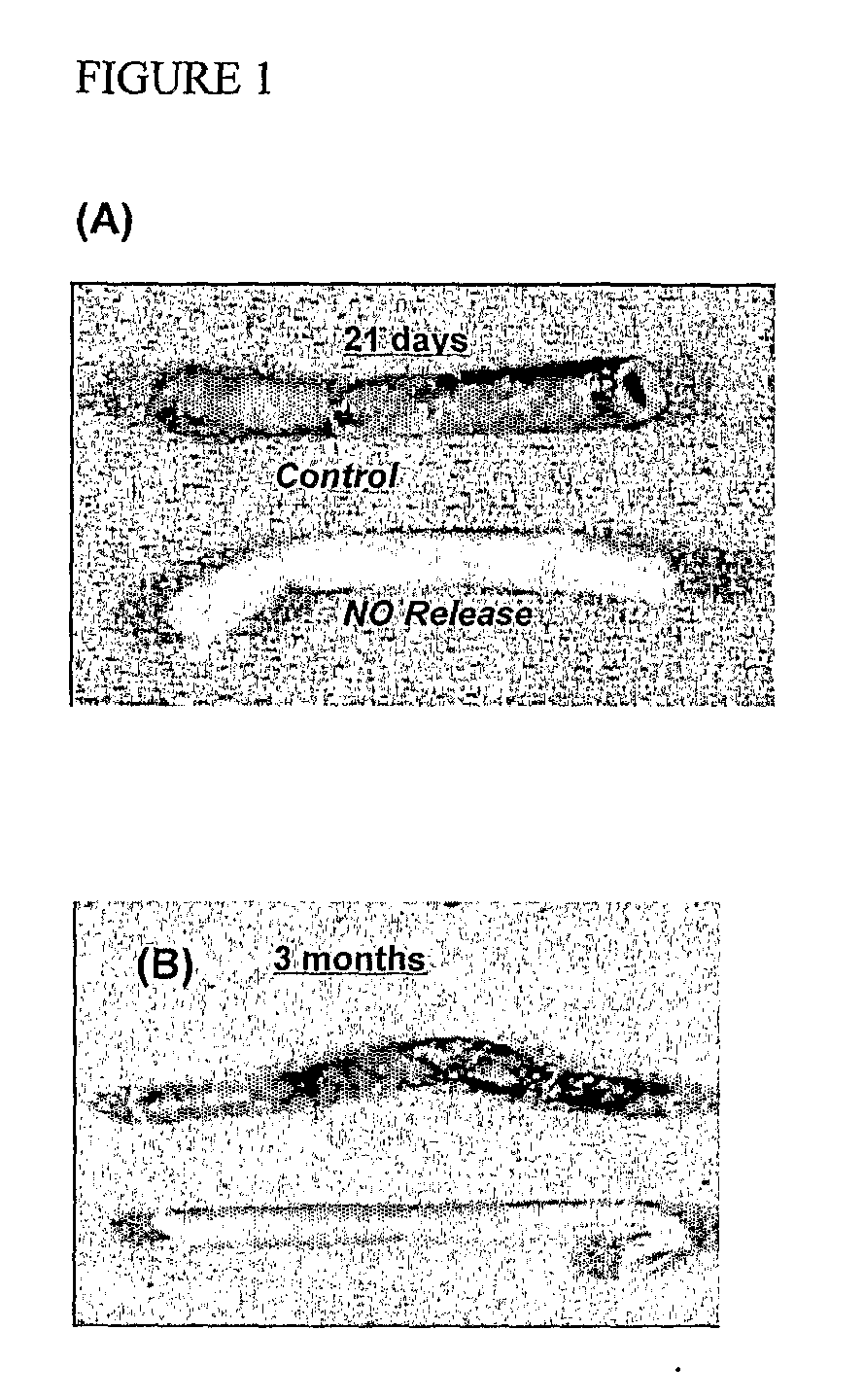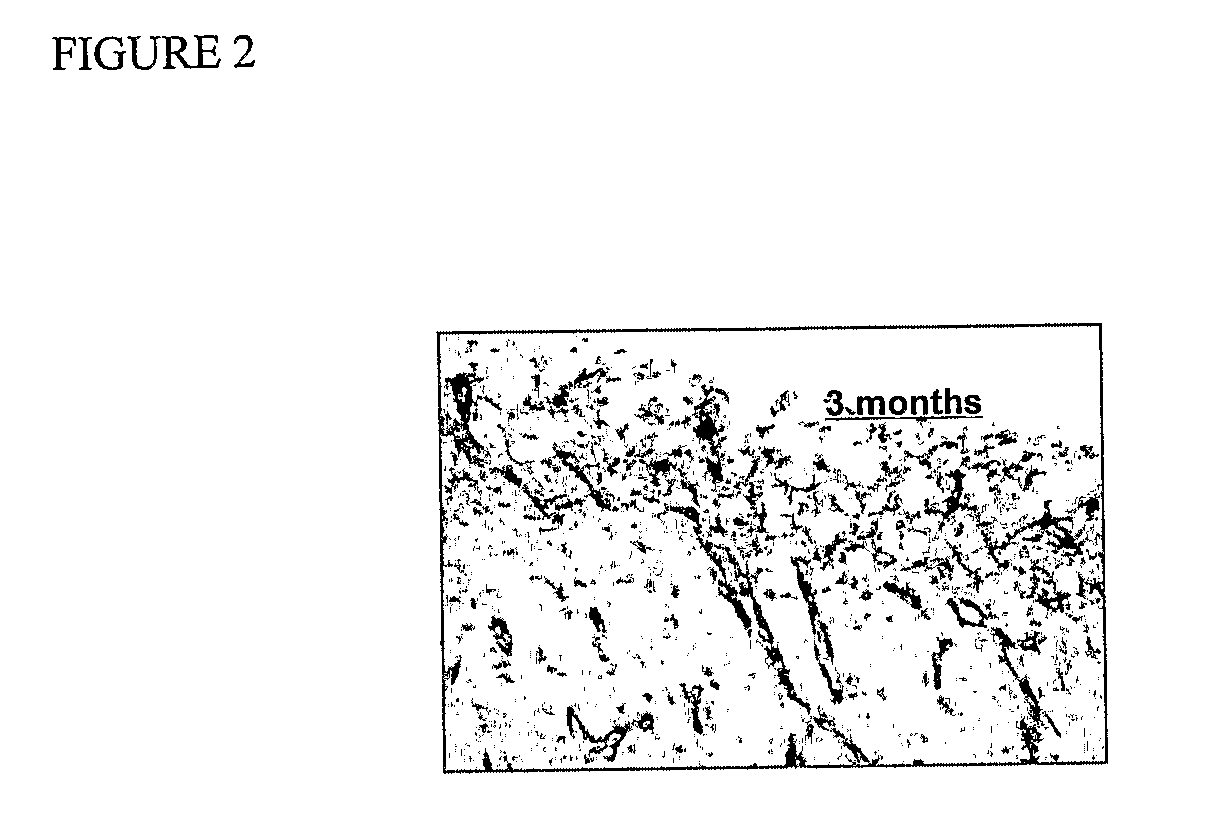Methods, Compositions and Devices For Promoting Anglogenesis
a technology of anglogenesis and compositions, applied in the direction of prosthesis, blood vessels, nitro compound active ingredients, etc., can solve the problems of platelet activation, vascular stenosis, underlying smooth muscle cell proliferation, etc., to enhance blood perfusion in peripheral tissue, enhance blood perfusion in neural tissue, and enhance blood perfusion in myocardial cells
- Summary
- Abstract
- Description
- Claims
- Application Information
AI Technical Summary
Benefits of technology
Problems solved by technology
Method used
Image
Examples
example 1
Sheep Model
[0169]A total of 12 grafts were placed in six sheep in a blinded, randomized study: NO-releasing grafts (n=5 grafts); sham-coated control grafts (n=4 grafts); uncoated control grafts (n=3 grafts). Small-diameter polyurethane vascular grafts (5-mm internal diameter; 25-cm length; Vectra™ vascular access graft, Bard-Impra, Murray Hill. N.J.) were coated with a NO-releasing multi-layer PVC material containing the NO donor.
[0170]Vascular grafts were dip-coated to create multi-layer films of plasticized poly(vinyl chloride) on the inner surface. Control grafts were either uncoated or sham-coated grafts of equivalent size and length. Sham-coated control grafts were prepared with the same polymer layers used in the NO-releasing grafts, however the NO-releasing compound and anion additive were absent. Grafts were explanted after 21 d.
example 2
Factor VIII
[0171]FIG. 2 illustrates a sample immunostained with Factor VIII. An endogenous peroxidase block is used with the sample, with 20 minutes of 0.3% H2O2, and then rinsed with PBS 3×. A 10% serum from species of secondary antibody (i.e. if secondary is goat anti-mouse, use goat serum) for 10 minutes is used. A Zymed CAS blocking reagent (universal blocking) may be used. A primary antibody is used for 30-90 minutes, and rinsed with PBS 3×-2 minutes. A secondary antibody is used for 30 minutes and then rinsed with PBS 3×-2 minutes, followed by an enzyme conjugate for 20-30 minutes, and rinse with PBS 3×-2 minutes. DAB, AEC Chromagen is used, and development of color is watched with microscope, around 2-5 minutes. Rinse with dH2O. The sample is counterstained with hematoxylin. Coverslip with synthetic or aqueous mounting media as required for specific chromagen. Alternatively, an anti-VEGF antibody is used as specific to vascular endothelial cells.
example 3
[0172]The effect of NO on tissue incorporation was examined on the outer surface of the grafts following three week (six sheep) and three month (three sheep) implantation. FIG. 1 (A&B) shows representative explanted grafts at both time points. NO-releasing grafts showed reduced incorporation of the fibrotic capsule into the graft surface (abluminal) as compared to sham-coated, non-NO releasing grafts. Sections of the capsule surrounding the grafts were immunostained for Factor VIII and VEGF. FIG. 2 shows prominent Factor VIII staining in the area immediately surrounding the graft. Tissue farther up and downstream of the graft does not show this staining pattern, nor does the tissue around the control grafts. VEGF staining was also seen at the interface of the non-adherent tissue adjacent to the abluminal surface of the graft. The effect of NO on tissue incorporation is prolonged. For the three month implant studies, NO was released for only 21 d, yet the effect on tissue incorporati...
PUM
| Property | Measurement | Unit |
|---|---|---|
| temperature | aaaaa | aaaaa |
| temperature | aaaaa | aaaaa |
| time | aaaaa | aaaaa |
Abstract
Description
Claims
Application Information
 Login to View More
Login to View More - R&D Engineer
- R&D Manager
- IP Professional
- Industry Leading Data Capabilities
- Powerful AI technology
- Patent DNA Extraction
Browse by: Latest US Patents, China's latest patents, Technical Efficacy Thesaurus, Application Domain, Technology Topic, Popular Technical Reports.
© 2024 PatSnap. All rights reserved.Legal|Privacy policy|Modern Slavery Act Transparency Statement|Sitemap|About US| Contact US: help@patsnap.com










